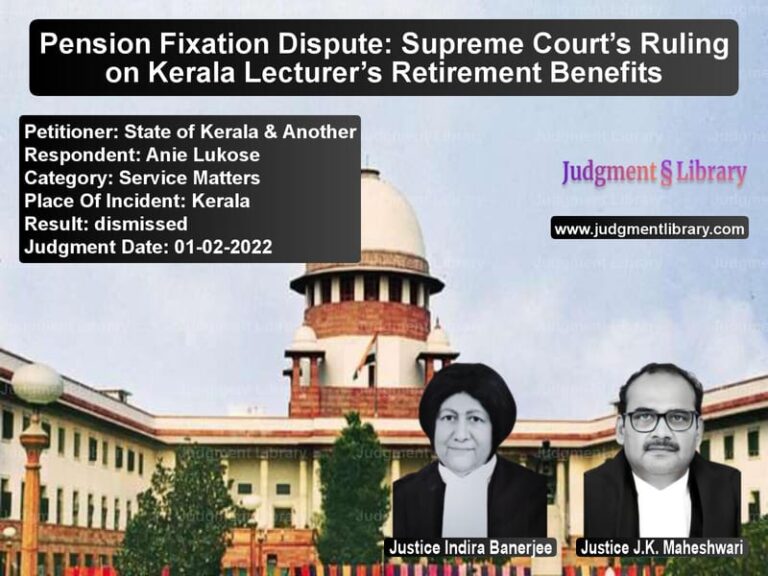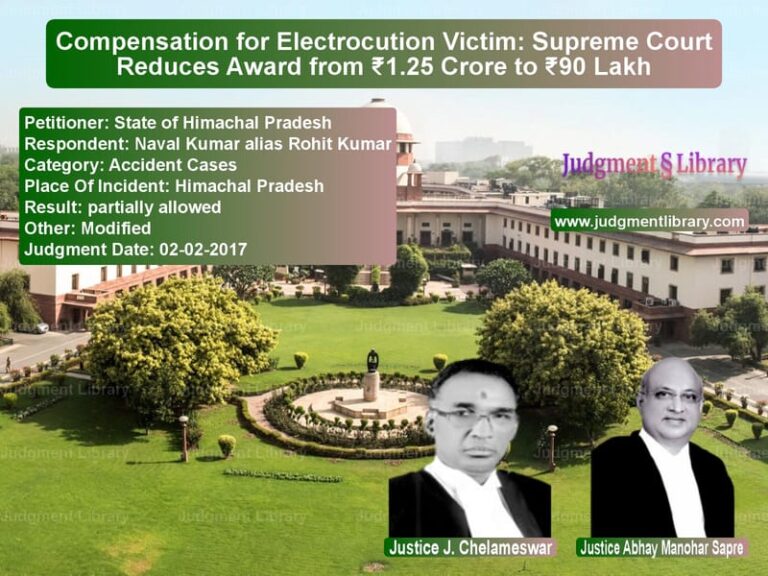Supreme Court Modifies Murder Conviction to Culpable Homicide: A Landmark Ruling on Section 304 IPC
The case of Sankath Prasad vs. State of Uttar Pradesh is a crucial judgment that clarifies the distinction between murder (Section 302 IPC) and culpable homicide not amounting to murder (Section 304 Part I IPC). The Supreme Court re-examined the evidence and found that the act was not premeditated but a result of a sudden quarrel. Consequently, the Court modified the conviction from life imprisonment under Section 302 IPC to a 10-year sentence under Section 304 Part I IPC.
This ruling provides guidance on how courts should interpret sudden provocation, intent, and the degree of culpability when determining the appropriate charges and punishment in homicide cases.
Background of the Case
The incident took place on August 25, 1985, at around 8:45 AM in Fatehpur, Uttar Pradesh. The sequence of events unfolded as follows:
- The complainant, Gaya Prasad, was returning home when he saw the appellant’s brother, Durga Prasad, digging a mound with two laborers, including Ram Nath (PW2).
- Gaya Prasad objected to the digging, which led to an argument between him and Durga Prasad.
- The appellant, Sankath Prasad, joined the altercation, and a verbal confrontation ensued.
- As the argument escalated, the appellant went inside his house and came back armed with a country-made pistol.
- While aiming at Gaya Prasad, the complainant’s son, Uma Shanker, intervened and tried to restrain the appellant by grabbing him from behind.
- The appellant managed to free himself and fired at Uma Shanker, causing a fatal injury.
- Uma Shanker succumbed to the gunshot wound, and an FIR was lodged against the appellant.
Trial Court Proceedings
The case was tried before the IIIrd Additional Sessions Judge, Fatehpur, in Sessions Trial No. 59 of 1986. The court relied on:
- The testimony of eyewitnesses Gaya Prasad (PW1) and Ram Nath (PW2), who confirmed that the appellant had fired the fatal shot.
- The post-mortem report, which revealed a single gunshot wound to the chest, supporting the prosecution’s case.
- The testimony of the medical officer, Dr. (PW4), who stated that the injury was caused by a firearm and was sufficient to cause death.
Based on this evidence, the trial court convicted the appellant under Section 302 IPC and sentenced him to life imprisonment.
High Court Proceedings
The appellant challenged his conviction before the Allahabad High Court in Criminal Appeal No. 2546 of 1987. The High Court upheld the trial court’s ruling, stating that:
- The eyewitness testimonies were consistent and credible.
- The appellant had deliberately fetched a gun, demonstrating intent.
- The presence of blackening and tattooing around the wound indicated that the shot was fired from close range, ruling out accidental discharge.
The appeal was dismissed, and the appellant remained in prison.
Supreme Court Proceedings
The appellant then approached the Supreme Court, arguing that:
- The incident was a sudden altercation and not a premeditated murder.
- The act was committed in the heat of passion, and he did not intend to kill.
- He should be convicted under Section 304 IPC instead of Section 302 IPC.
Supreme Court’s Observations
- The Court recognized that the dispute arose over the excavation of a mound and was not a planned attack.
- The appellant retrieved a gun, but the firing occurred during a sudden quarrel, suggesting an impulsive act rather than a deliberate killing.
- The deceased, Uma Shanker, intervened to stop the altercation and was shot in the process.
- The Court applied Exception 4 of Section 300 IPC, which states that a killing during a sudden fight without premeditation may be classified as culpable homicide, not murder.
- The judgment emphasized: “Having regard to the circumstances of the case, we are of the view that the conviction under Section 302 IPC should be converted to one under Section 304 Part I IPC.”
Final Judgment
The Supreme Court modified the conviction and sentence as follows:
- The conviction under Section 302 IPC (murder) was reduced to Section 304 Part I IPC (culpable homicide not amounting to murder).
- The appellant was sentenced to 10 years of rigorous imprisonment instead of life imprisonment.
- The appeal was partially allowed, modifying the original verdict.
This ruling reinforces the importance of analyzing intent and provocation in homicide cases and serves as a precedent for courts to distinguish between murder and culpable homicide.
Petitioner Name: Sankath Prasad.Respondent Name: State of Uttar Pradesh.Judgment By: Justice Dhananjaya Y Chandrachud, Justice Hrishikesh Roy.Place Of Incident: Fatehpur, Uttar Pradesh.Judgment Date: 10-01-2020.
Don’t miss out on the full details! Download the complete judgment in PDF format below and gain valuable insights instantly!
Download Judgment: Sankath Prasad vs State of Uttar Prade Supreme Court of India Judgment Dated 10-01-2020.pdf
Direct Downlaod Judgment: Direct downlaod this Judgment
See all petitions in Murder Cases
See all petitions in Bail and Anticipatory Bail
See all petitions in Judgment by Dhananjaya Y Chandrachud
See all petitions in Judgment by Hrishikesh Roy
See all petitions in partially allowed
See all petitions in Modified
See all petitions in supreme court of India judgments January 2020
See all petitions in 2020 judgments
See all posts in Criminal Cases Category
See all allowed petitions in Criminal Cases Category
See all Dismissed petitions in Criminal Cases Category
See all partially allowed petitions in Criminal Cases Category







